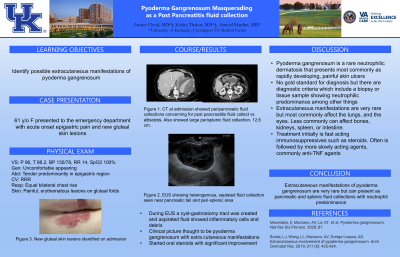Sunday Poster Session
Category: Biliary/Pancreas
P0155 - Pyoderma Gangrenosum Masquerading as a Post Pancreatitis Fluid Collection
Sunday, October 22, 2023
3:30 PM - 7:00 PM PT
Location: Exhibit Hall


Amber Cloud, MD
University of Kentucky
Lexington, KY
Presenting Author(s)
Amber Cloud, MD, Kshitij Thakur, MD, MSc, Samuel Mardini, MD, MBA, MPH
University of Kentucky, Lexington, KY
Introduction: We report a patient with an unusual presentation of pyoderma gangrenosum with an extracutaneous manifestation.
Case Description/Methods: 61-year-old female presented to the emergency room with epigastric pain and new gluteal skin lesions. CT scan imaging revealed multiple peripancreatic fluid collections, which raised concern for post pancreatitis fluid collection versus abscess. An endoscopic ultrasound (EUS) with fine-needle aspiration and drainage of the peripancreatic collection was performed, which showed a 4-5 cm fluid collection in the pancreatic body and a 9 x 7 cm large heterogenous septated anechoic fluid collection in the pancreatic tail region. A cyst-gastrostomy tract was created, and a lumen opposing metal stent was placed successfully. The fluid aspirated from the cystic cavity showed numerous acute inflammatory cells and debris, but no evidence of malignancy.
During this hospitalization, the patient was also found to have new bilateral gluteal lesions concerning for pyoderma gangrenosum. The peripancreatic collection were also believed to be an extra cutaneous manifestation for Pyoderma gangrenosum. After seeing the outpatient dermatologist, she was started on oral steroids to treat the gluteal skin findings, which significantly improved her skin lesions and peripancreatic fluid collection seen on repeat CT scan four weeks later. The stent placed in the cyst-gastrostomy tract was removed after 12 weeks.
Discussion: Pyoderma gangrenosum rarely can have extracutaneous manifestations, such as sterile neutrophilic infiltrates in various organs. The most common extracutaneous manifestation is culture-negative pulmonary infiltrates, which can be potentially fatal. Other organ systems that may be involved include the heart, central nervous system, gastrointestinal tract, eyes, liver, bones, and lymph nodes. The treatment for pyoderma gangrenosum in patients with underlying visceral involvement involves the use of anti-inflammatory agents, including antibiotics, corticosteroids, immunosuppressive agents, and biologic agents. Glucocorticosteroids are usually effective, but some patients may require immunosuppressants such as cyclosporine and dapsone. In refractory cases, biologics such as infliximab, adalimumab, and etanercept may be used.
Disclosures:
Amber Cloud, MD, Kshitij Thakur, MD, MSc, Samuel Mardini, MD, MBA, MPH. P0155 - Pyoderma Gangrenosum Masquerading as a Post Pancreatitis Fluid Collection, ACG 2023 Annual Scientific Meeting Abstracts. Vancouver, BC, Canada: American College of Gastroenterology.
University of Kentucky, Lexington, KY
Introduction: We report a patient with an unusual presentation of pyoderma gangrenosum with an extracutaneous manifestation.
Case Description/Methods: 61-year-old female presented to the emergency room with epigastric pain and new gluteal skin lesions. CT scan imaging revealed multiple peripancreatic fluid collections, which raised concern for post pancreatitis fluid collection versus abscess. An endoscopic ultrasound (EUS) with fine-needle aspiration and drainage of the peripancreatic collection was performed, which showed a 4-5 cm fluid collection in the pancreatic body and a 9 x 7 cm large heterogenous septated anechoic fluid collection in the pancreatic tail region. A cyst-gastrostomy tract was created, and a lumen opposing metal stent was placed successfully. The fluid aspirated from the cystic cavity showed numerous acute inflammatory cells and debris, but no evidence of malignancy.
During this hospitalization, the patient was also found to have new bilateral gluteal lesions concerning for pyoderma gangrenosum. The peripancreatic collection were also believed to be an extra cutaneous manifestation for Pyoderma gangrenosum. After seeing the outpatient dermatologist, she was started on oral steroids to treat the gluteal skin findings, which significantly improved her skin lesions and peripancreatic fluid collection seen on repeat CT scan four weeks later. The stent placed in the cyst-gastrostomy tract was removed after 12 weeks.
Discussion: Pyoderma gangrenosum rarely can have extracutaneous manifestations, such as sterile neutrophilic infiltrates in various organs. The most common extracutaneous manifestation is culture-negative pulmonary infiltrates, which can be potentially fatal. Other organ systems that may be involved include the heart, central nervous system, gastrointestinal tract, eyes, liver, bones, and lymph nodes. The treatment for pyoderma gangrenosum in patients with underlying visceral involvement involves the use of anti-inflammatory agents, including antibiotics, corticosteroids, immunosuppressive agents, and biologic agents. Glucocorticosteroids are usually effective, but some patients may require immunosuppressants such as cyclosporine and dapsone. In refractory cases, biologics such as infliximab, adalimumab, and etanercept may be used.
Disclosures:
Amber Cloud indicated no relevant financial relationships.
Kshitij Thakur indicated no relevant financial relationships.
Samuel Mardini indicated no relevant financial relationships.
Amber Cloud, MD, Kshitij Thakur, MD, MSc, Samuel Mardini, MD, MBA, MPH. P0155 - Pyoderma Gangrenosum Masquerading as a Post Pancreatitis Fluid Collection, ACG 2023 Annual Scientific Meeting Abstracts. Vancouver, BC, Canada: American College of Gastroenterology.
